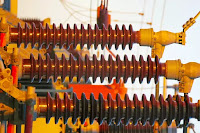What is insulator, material, features, and types Overhead Line Insulator?
Insulators
Many of us who are more or less familiar with the power
management knows that many types of insulators are used in overhead lines.
These
insulators play a very important role in transmission and distribution lines.
In this article, we will discuss several things about insulators. E.g.
- What is an insulator?
- Insulating material.
- Insulator properties.
- Types of insulators.
{tocify} $title={Table of Contents}
What is an insulator?
The insulator is a type of non-conductive material used to hold
the conductor in an overhead line and to isolate the conductor from other metal
parts, including the cross arm of the pole or tower.
The following figure shows some of the insulators-

Different types of insulators are used in almost all the
towers, poles, or poles used to transmit electricity from the power plant to our
homes or offices.
In addition to these lines, insulators are used in much
electrical equipment including transformers.
Basically, the function of these insulators is to keep the
conductors of the line separate from the cross arm and the pole or tower so
that they do not come in contact with each other or the earth.
Insulating materials
The materials used to make insulators are called insulating
materials. Here are some common types of insulating materials:
- Porcelain
- Glass
- Steatite
- Pyrex
Among these materials, porcelain insulators are used in
large quantities.
Insulator Features
Generally, an insulator should have the following
properties-
1. Must have the high mechanical strength to withstand
conductor load, wind pressure, etc.
2. Insulator material must have high electrical resistance
to avoid the earth's current leakage.
3. The insulator material should be flawless and free from
adulteration, otherwise, its effectiveness will be reduced.
4. The ratio of a puncture in flashover should be kept
correct.
5. Relative permittivity should be high, it has high
die-electric power.
6. The ratio of puncture voltage to spark over voltage
should be high.
7. Care should be taken while making the insulator so that
no gas or liquid can enter the corner.
8. In addition, due to the change in temperature, it should
be made keeping in mind that there is no reaction in the corners.
Flashover
Electrical discharge around the insulator / on
the surface of the insulator is flashover.
That is, many times we suddenly see
a flash of fire around the insulator and discharge very quickly, this is
basically a flashover.
Types of insulators
Different types of insulators are used in transmission and
distribution lines. Here are some important insulators:
1. Shackle or feel or spool insulator
2. Pin insulator
3. Suspension insulator
4. Strain insulator
5. Post insulator
6. Stay or Guy insulator

